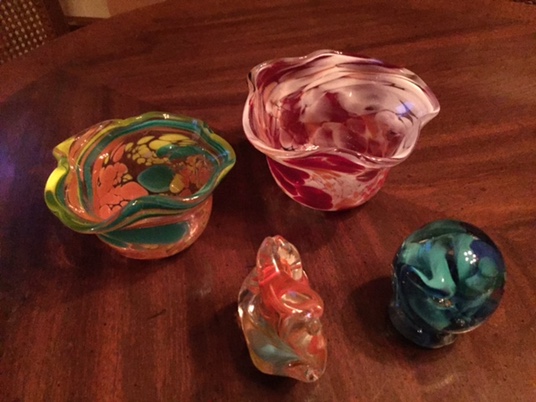
What do chickens have to do with glass? And what in the world do bubbles have to do with glass blowing? The answers are: the rooster is a mascot of sorts and the bubbles are part of a really old art form. Get out to the Glass Bubble Project behind Nanobrew in Ohio City — the neighborhood behind the West Side that’s been on my “most fun” list for 25 years.
The Glass Bubble Project, a gallery where you can learn to make a paperweight or a fluted vase, has as its mascot a rooster that needs to be trimmed. The first time I wandered into the space, it was the rooster, more than the glass art, that caught my attention. But I went home with a blue and green bowl that caught my eye and now sits on a table in my family room.
My husband Paul and I returned on a recent Saturday afternoon in February so I could use the gift certificate he bought me for Christmas. I was nervous about working with hot glass and fiery ovens, especially after I was told to wear cotton and hard shoes, and tie my hair back when I called to make a reservation.
But we were welcomed warmly into the rough industrial room with cement floors. The walls to the left of us were lined with glass art, and the furnace and ovens were further down to the left. Long poles leaned against the furnaces; heavy boxes filled with serious hard metal tools sat on the floors. A couple of benches with notches for the poles were placed just opposite the ovens. Lights hung from an unfinished ceiling adorned with crazy glass chandeliers elongated into Medusa-like tendrils and beautifully sculpted pendants.
I shook hands with my instructor and he handed me a pair of leather gloves. We quickly established we were both Kent State grads who’d majored in liberal arts, but who had hearts devoted to discovering the artist within.
We got started. In the center of the room was a table adorned with bowls filled with broken glass of various colors that would melt into the hot glass. I was to hold the pole at the very end, because if my hands were down a foot on the pole, the gloves would smoke and my hands would become hot. I wore protective eye goggles. He showed me how to twirl the pole so the glass would move and take shape as it cooled. The 2100-degree furnace was where the crucible glass was stored and the glory hole was what we’d be working in to make the glass into art. He’d make a demonstration piece with my help as he showed me the techniques and then I’d make my own solid and blown pieces.
Glass blowing is an art that was discovered in the first century AD. I thought about the glass blowers I’d seen in Venice where the beauty of the raw material and the flow of the men’s bodies with the tools and the glass inspired me. During blowing, thinner layers of glass cool faster than thicker ones and become more viscous than the thicker layers. That allows production of blown glass with uniform thickness.
This was no less inspiring. Maybe more so since it was so down and dirty, so in the moment, so “OK, let’s do this right.” I got a private lesson with a man who was patient and helpful, who talked me through every step, from gathering the glass on the end of the pole to dipping it into the glass pieces in the bowls to swirling it and swinging it. He kept reminding me to keep the pole down, not up, because I instinctually held it up. I held the glass in the oven as it got warmer and warmer and the colored glass pieces adhered, and then I pulled it out to twirl again and repeated the steps until I had a paperweight.
And then he showed me how the bubble forms when you blow. “See the bubble?” he asked, and I looked hard, not seeing it at first, but then I did and realized how amazing it was. He made a bowl and then I did, blowing into the blowpipe and thinking no air was going into the glass as I blew harder, and then that bubble appeared and we were able to open it up and twist it with large industrial tweezers and pad the bottom flat and shape the edges into undulating beauty.
An hour and a half later, I left my work behind in the annealer where my pieces would slowly cool in a way that it wouldn’t crack or shatter due to thermal stress. I would return in a week to pick up the four pieces, two a shared demonstration piece and two totally my own creations. When I left to walk next door for a beer at Nanobrew with Paul, who’d been my audience, I felt that I’d had a precious time of learning something new, a precious life experience that will remain with me. I was also leaving behind a friend.
The Glass Bubble Project encourages you to get to know Morty the rooster and purchase some glass art. Bring your family, your girlfriends, your beer-drinking buddies, your church people, and learn how glass works together. Find out more at glassbubbleproject. And take a look at their new Facebook cover photo!